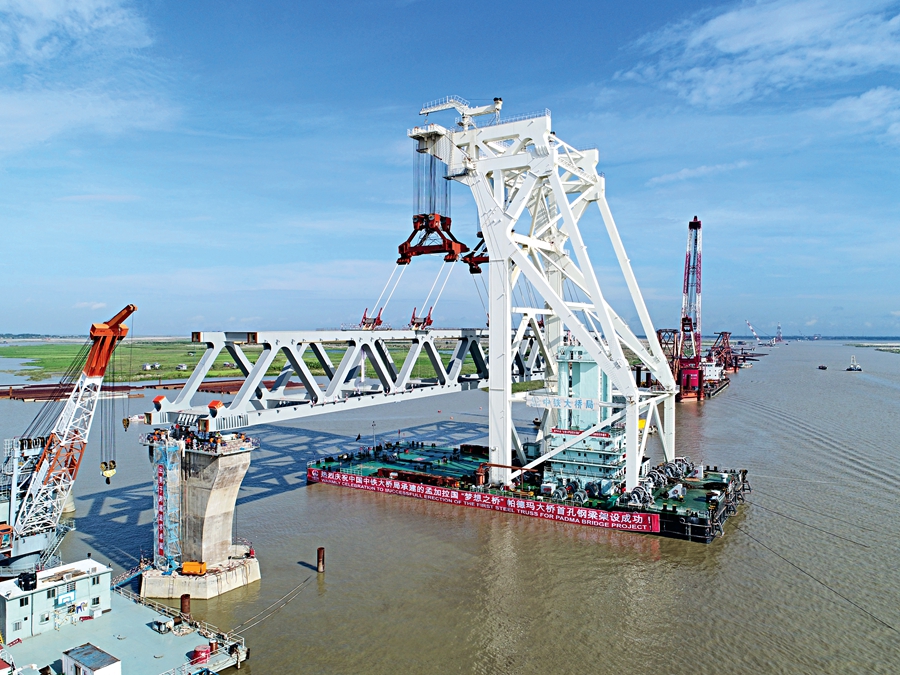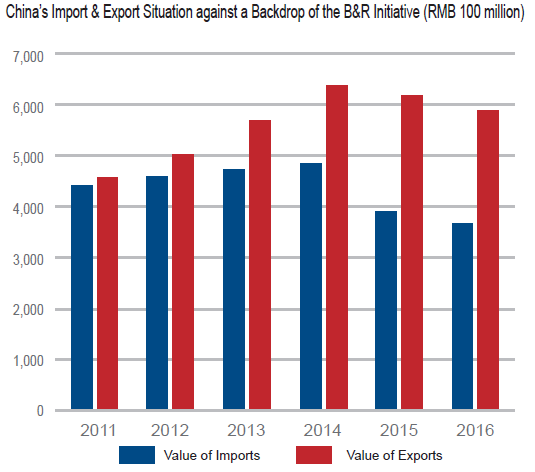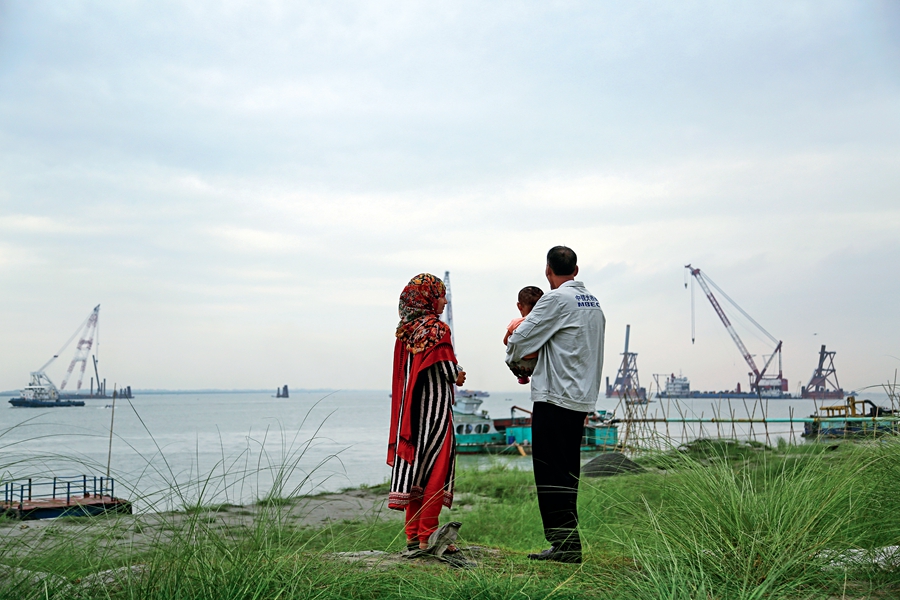THANKS to the Belt and Road Initiative, the Padma Bridge across the Padma River in Bangladesh, a dream of the locals, will soon become a reality. The bridge will connect 21 southern districts of the country with the capital Dacca, and link its northern and southern railway networks into a whole. Thus, the land route from China through Myanmar to Bangladesh will be greatly improved.
The construction feat will also boost trade and economic exchanges between India and Bangladesh, and advance the construction of the Bangladesh-China-India-Myanmar Economic Corridor to a new stage.

Workers erect the first steel truss of the Padma Bridge.
Chinese President Xi Jinping first proposed the Belt and Road Initiative in 2013, in which policy coordination, connectivity of facilities, unimpeded trade, financial integration, and people-to-people bonds are emphasized. No doubt, the Padma Bridge will improve connectivity of facilities among the related countries along the Belt and Road. Pushed forward by all parties concerned, the Belt and Road Initiative is seeing its cooperative results blooming, and has become an open and inclusive international cooperation platform and a well-received global public good.
A Long Aspired Bridge
“The Padma River is as important to the Bangladeshi people as the Yangtze River to the Chinese,” said Liu Ziming, a National People’s Congress (NPC) deputy and president of China Railway Major Bridge Engineering Group Co. Ltd. (MBEC), in an interview with China Today. The rolling Padma River is reputed as the water of life in Bangladesh. However, the river has also become a formidable barrier for the country to coordinate its economic development in north and south. In one of the most densely populated countries in the world, to reach the opposite bank of the river, Bangladeshi people have to first take a bus or a car, and change to a ferry, then bus or car again. Even if you arrive at the wharf in the early morning, it will still take you a whole day to cross the river. The ferryboat is thronged with passengers with some even sitting on the roof, according to Liu Ziming.
Despite the rising public cries for a bridge over the river, a variety of difficulties with regards to such factors as technology, capital, and policy inconsistency had barred it from becoming a reality.

The turning point appeared in 2014. China Railway Major Bridge Engineering Group won the bid for constructing the long aspired bridge. The company’s win owed a lot to its former cooperation with Bangladesh. In 2004, the Chinese bridge group was first selected to construct the country’s then largest bridge, the Paksey Bridge. The first time for the Chinese company to run a project in light of international rules, it earned recognition of the proprietor and the supervisor with its incredibly fast project completion speed and high construction quality. Later the company was commissioned to construct six small-sized bridges in the country. The past projects have built a good reputation for the company in Bangladesh. In the eyes of Khandker Anwarul Islam, executive director of Bangladesh Bridge Authority, China Railway Major Bridge Engineering Group is a competitive company.
The two-level steel truss bridge will carry a four-lane highway on the upper level and a single-track railway on the lower level, with total length of 6,150 meters and width 21.5 meters. Because of complicated local geological conditions, batter pile construction has been applied in building the foundation of the bridge. All these make the project the most difficult one for construction in the world compared with the same type of bridges.
A different design model and much more rigorous requirements for construction by the world-rate supervision company have forced the Chinese group to improve its performance in technology, communication, and adaptability. Its work has finally earned the Chinese company good repute, and led to the inclusion of some Chinese standards into the related category of international standards.
Now, with its construction and the construction of the railway connection project, the Padma Bridge is expected to become an important link in the Trans-Asian Railway, and an important project of the Belt and Road Initiative.
Sincerity, the Key to People-to-people Bonds
However, the construction process is fraught with complications. Liu told China Today that according to China’s domestic practices, for all bridge projects, the construction design is drawn immediately after the primary design of the bridge is done, and then the construction company can directly start its construction. However, for the Padma Bridge project, the designing organization left the construction site soon after they finished the primary design. Therefore, the work to determine related parameters of the engineering project was left to the construction company under the supervision of on-site supervising engineers. It took the Chinese company nearly two years.
At a press conference held on March 8 on the sidelines of the annual session of the NPC, Chinese Foreign Minister Wang Yi said, “The Belt and Road Initiative is a transparent initiative launched by China. It follows the golden rules of extensive consultation, joint contribution, and shared benefits.” He then added that cooperation under the initiative aims to be based on equal footing, inclusive, and universally beneficial. Wang Yi went on to say, “The planning and implementation of the initiative’s projects are discussed by the participants in the open. No country is dominating the process. All parties have an equal say. There is no backroom deal. Everything is transparent. There is no winner taking all. Every project seeks win-win results.”
During their stay in Bangladesh Chinese workers and engineers have had closer exchanges with local people and government, their emotions towards the country have become increasingly deeper, thus strong people-to-people bonds between the two countries formed.
On the construction site of the Padma Bridge, much work has also been done by local workers. Many of them, following the Chinese company, have participated in the construction of multiple bridges. Now, as old friends of Chinese people, they have become adept in the bridge construction field.
According to Liu Ziming, over 400 Chinese technicians and over 2,000 Bangladeshi workers are hired for the Padma Bridge project. The 27-year-old MD Shohel Rana has been working with the MBEC for five years, having grown from a young graduate who has no experience in engineering construction to a veteran who is now able to independently carry out engineering tests. He admitted that Yang Pinxiang, his Chinese mentor, has taught him much. The Padma Bridge is the second project he participated in with Yang. He said that the experience with this project will enrich his resume, so that he will have better employment prospects for the future.

A local resident, also the chief steward of the Padma Bridge Project, with his daughter and grandson, admires the construction of the Bangladeshi dream bridge.
Abdul Malek is a Muslim and he prays at the prescribed times every day. He is experienced in engineering testing, and was recommended by his former employer to participate in the Padma Bridge project. In the very beginning, he was not sure if he would adapt to a Chinese enterprise well. But soon he found that the Chinese enterprise has advanced technologies and the Chinese employer is very considerate to make it convenient for him to pray. “I feel blessed to be able to participate in the construction of this dream bridge,” he said.
The Padma Bridge connects not only the countries of China and Bangladesh, but also the two peoples, who are now working together to build a better future.
The bridge is expected to benefit local people, promote regional cooperation and communication. Since the beginning of the Belt and Road Initiative, many projects with the same aim have been launched or completed, such as the Mombasa-Nairobi Standard Gauge Railway, Hungary-Serbia Railway, China-Laos Railway, China-Thailand Railway, Jakarta-Bandung High-speed Railway, second line for the China-Russia oil pipeline, China-Belarus Industrial Park, and the China-Thailand Rayong Industrial Zone. Data show that over 140 countries have participated in or responded positively to the Belt and Road Initiative, and 86 countries and international organizations have signed 101 cooperation agreements with China under the initiative. China-Europe express freight train service has made a total of 6,637 trips, with 3,673 trips made last year.
During China’s 2018 two sessions, the National Development and Reform Commission released the Report on the Implementation of the 2017 Plan for National Economic and Social Development and on the 2018 Draft Plan for National Economic and Social Development, which said that by making the Belt and Road Initiative a priority, China has seen stable and healthy development of a new system for an open economy. Efforts will be made to improve the quality of foreign investment in China and Chinese investment abroad, and further open China to the world.
Igniting the Potential of Global Development
The Belt and Road Initiative is expected to help people in countries along the routes to realize their dreams for prosperity and development. The Economist magazine commented that almost all the relevant countries want to participate in the Belt and Road Initiative.
In March China Today interviewed a few foreign diplomats to China when they sat in at the first session of 13th NPC in Beijing. They all expressed interest in the inclusive development that benefits all and open and pragmatic cooperation that China is seeking. Mumtaz Zahra Baloch, minister and deputy chief of mission, Embassy of Pakistan in Beijing, said that the China-Pakistan Economic Corridor which is under construction plays an important role in boosting the connectivity between the two countries. It starts in Kashgar of China’s Xinjiang and stretches to Gwadar Port of Pakistan, covering a vast network of highways, railways, oil and gas pipelines, and optical fiber cables. Leela Mani Paudyal, ambassador of Nepal to China, pointed out that inclusive economic growth and an open policy is important to both China and the world.
The Belt and Road Initiative proposed by China aims at boosting economic growth with participants’ experience, technology, and funds. If all the countries along the Belt and Road can connect with each other, the development potential of Eurasia, which has 70 percent of the world’s population and 75 percent of the world’s total energy resources, will be ignited.
On March 11, Minister of Commerce Zhong Shan said at a press conference on the sidelines of the first session of the 13th NPC in Beijing that the import and export volume between China and the Belt and Road countries hit US $1.1 trillion in 2017. So far 75 economic and trade cooperation zones have been established in relevant countries, with a total investment of more than US $27 billion.
China will work together with other Belt and Road countries to build the Belt and Road into a road for peace, prosperity, openness, and innovation, as well as a road connecting different civilizations.
The Belt and Road Initiative is inclusive, which aligns with the development strategies of countries and regions along the routes, such as Russia’s Eurasian Economic Union, Mongolia’s passage to grassland initiative, Kazakhstan’s “Bright Road” Initiative, and EU’s Juncker Plan. Today different countries and regions are increasingly interdependent, forming a community of shared interests, thus only joint efforts can boost global economic development.
As the Belt and Road Initiative becomes increasingly popular, it will sure inject new impetus into globalization.





